How Can Cities Respond to Flood Disaster Risks under Multi-Scenario Simulation? A Case Study of Xiamen, China
Abstract
:1. Introduction
2. Literature Review
3. Materials and Methods
3.1. Overview of the Study Area
3.2. Methods
3.2.1. Index System
3.2.2. Calculation of Indicator Weights
- The original data form the matrix X:
- By normalizing the raw data, a new matrix Y is obtained:
- Then the entropy value is derived as:
- The weight Wj is calculated based on the entropy value:where Xij is an element in matrix X, t is the number of years, m is the number of indicators, n is the number of samples and ej is the entropy value.
3.2.3. Methods of Multi-Scenario Flood Risk Assessment
4. Results
4.1. Hazard Analysis of Disaster Factors
4.2. Sensitivity Analysis of the Environment
4.3. Vulnerability ANALYSIS of the Disaster-Bearing Body
4.4. Analysis of the Disaster Prevention and Resilience
4.5. Assessment and Analysis of Flood Disasters under Different Scenarios
4.6. Division of Flood Control Zones
5. Discussion
6. Conclusions
Author Contributions
Funding
Acknowledgments
Conflicts of Interest
References
- EMDAT-The International Emergency Disasters Database. Available online: http: //www.emdat.be (accessed on 11 January 2019).
- Dilley, M.; Chen, R.S.; Deichmann, U.; Lerner-Lam, A.L.; Arnold, M.; Agwe, J.; Buys, P.; Kjevstad, O.; Lyon, B.; Yetman, G. Natural Disaster Hotspots: A Global Risk Analysis; The World Bank Group: Washington, DC, USA, 2005; Volume 20, pp. 1–145. ISBN 0-8213-5930-4. [Google Scholar]
- Shenzhen Meteorological Data System. Available online: https://data.szmb.gov.cn/wdn/ (accessed on 11 January 2019).
- Luke, A.; Mac Ogonor, C.U. Climate change, environmental security and displacement in Nigeria: Experience from the Niger Delta Flood Disaster, 2012. Afr. J. Environ. Sci. Technol. 2015, 9, 53–64. [Google Scholar] [CrossRef]
- Gu, X.; Li, N.; Zhou, Y.; Wu, J. Thinking on urban waterlogging disaster defense initiated by “7·21” extraordinary rainstorm in Beijing. J. Nat. Disaster 2013, 2, 1–6. [Google Scholar] [CrossRef]
- Zhou, Z.; Liu, S.; Zhong, G.; Cai, Y. Flood Disaster and Flood Control Measurements in Shanghai. Nat. Hazards Rev. 2016, 18, B5016001. [Google Scholar] [CrossRef]
- Huang, C.; Guo, J.; Ai, F.; Wu, T. Basic paradigm of risk analysis in flood disaster and its application. J. Nat. Disasters 2013, 11–23. [Google Scholar] [CrossRef]
- Smith, K. Environmental Hazards: Assessing Risk and Reducing Disaster; Routledge: New York, NY, USA, 1996; ISBN 9780415681056. [Google Scholar]
- Leit, O.J.P.; Almeida, M.D.C.; Sim Es, N.E.; Martins, A. Methodology for qualitative urban flooding risk assessment. Water Sci. Technol. 2013, 68, 829–838. [Google Scholar] [CrossRef] [PubMed]
- Kapil, G. Urban flood resilience planning and management and lessons for the future: A case study of Mumbai, India. Urban Water J. 2007, 4, 183–194. [Google Scholar] [CrossRef]
- Li, Q. The Research and Improvement of Risk Analysis and Evaluation Method on Flood Disaster. Ph.D. Thesis, Huazhong University of Science and Technology, Huazhong, China, 2012. [Google Scholar]
- Jonkman, S.N.; Vrijling, J.K.; Vrouwenvelder, A.C.W.M. Methods for the estimation of loss of life due to floods: A literature review and a proposal for a new method. Nat. Hazards 2008, 46, 353–389. [Google Scholar] [CrossRef]
- Feng, P.; Cui, G.; Zhong, Z. Assessment and prediction of direct economic losses from urban flood disasters. J. Hydraul. Eng. 2001, 64–68. [Google Scholar] [CrossRef]
- Chen, M.; Zhou, F.; Ma, J.; Chen, G.; Ni, H.; Hu, Y. Water damage loss function and flood damage assessment. J. Hydraul. Eng. 2015, 883–891. [Google Scholar] [CrossRef]
- Quan, R. Risk assessment of flood disaster in Shanghai based on spatial–temporal characteristics analysis from 251 to 2000. Environ. Earth Sci. 2014, 11, 4627–4638. [Google Scholar] [CrossRef]
- Xia, X.; Zhu, X.; Pan, Y.; Zhang, J. Research on natural disaster assessment methods based on historical cases. J. Catastrophol. 2016, 219–225. [Google Scholar] [CrossRef]
- Zhang, D.; Yan, D.; Wang, Y.; Lu, F.; Liu, S. Research progress on risk assessment and comprehensive response of urban disasters. J. Catastrophol. 2014, 1, 144–149. [Google Scholar] [CrossRef]
- Wu, L.; He, D.; Hong, W.; Ji, Z. Progress in natural disaster risk assessment and disaster vulnerability research. J. Catastrophol. 2014, 4, 129–135. [Google Scholar] [CrossRef]
- Chu, W.; Peng, D.; Xu, Z.; Meng, D.; Zhen, T. Risk analysis of urban storms and floods based on MIKE 11 and MIKE 21. J. Beijing Norm. Univ. (Nat. Sci.) 2014, 5, 446–451. [Google Scholar]
- Chowdhury, M.R. An Assessment of Flood Forecasting in Bangladesh: The Experience of the 1998 Flood. Nat. Hazards 2000, 22, 139–163. [Google Scholar] [CrossRef]
- Paquier, A.; Mignot, E.; Bazin, P.H. From Hydraulic Modelling to Urban Flood Risk. Procedia Eng. 2015, 115, 37–44. [Google Scholar] [CrossRef] [Green Version]
- Abdalla, R.; Elawad, Y.; Chen, Z.; Han, S.S.; Xia, R. A GIS-supported fuzzy-set approach for flood risk assessment. Can. Water Resour. J. 2014, 39, 3–14. [Google Scholar] [CrossRef]
- Liu, R.; Chen, Y.; Wu, J.; Gao, L.; Barrett, D.; Xu, T.; Li, L.; Huang, C.; Yu, J. Assessing spatial likelihood of flooding hazard using naive Bayes and GIS: A case study in Bowen Basin, Australia. Stoch. Environ. Res. Risk Assess. 2016, 30, 1575–1590. [Google Scholar] [CrossRef]
- Benito, G.; Lang, M.; Barriendos, M.; Llasat, M.C.; Francés, F.; Ouarda, T.; Thorndycraft, V.; Enzel, Y.; Bardossy, A.; Coeur, D.; et al. Use of Systematic, Palaeoflood and Historical Jata for the Improvement of Flood Risk Estimation. Rev. Sci. Methods Nat. Hazards 2004, 31, 623–643. [Google Scholar] [CrossRef]
- Nott, J. Extreme Events: A Physical Reconstruction and Risk Assessment; Cambridge University Press: Cambridge, UK, 2006; ISBN 0521824125. [Google Scholar]
- Qin, N.; Jiang, W. GIS-based flood risk zoning and evaluation in the middle and lower reaches of the Yangtze River. J. Nat. Disasters 2005, 5, 5–11. [Google Scholar] [CrossRef]
- Huang, C.; Liu, L. Agricultural natural disaster risk assessment method based on historical disaster data. J. Nat. Disasters 1998, 2, 1–9. [Google Scholar]
- Shi, P.; Liu, X. The theory and practice of regional flood risk assessment model research. J. Nat. Disasters 2001, 66–72. [Google Scholar] [CrossRef]
- Liu, D.; Du, P. Calculation method for the return period of hydrological elements under different conditions. Hydrology 2014, 1–5, 74. [Google Scholar] [CrossRef]
- Yan, J.; Zuo, Z. Research on Index System and Method of Natural Disaster Risk Assessment. Chin. Saf. Sci. J. 2010. [Google Scholar] [CrossRef]
- Li, Y.; Hu, T.; Pan, Y.; Lei, X.; Xie, J.; Xu, L.; Wang, X. Research progress on urban disaster simulation and disaster risk assessment. Geogr. Inf. World 2017, 6, 42–49. [Google Scholar] [CrossRef]
- Kaplan, S.; Garrick, B.J. On The Quantitative Definition of Risk. Risk Analysis. 1981, 1, 11–27. [Google Scholar] [CrossRef] [Green Version]
- Sun, A. Risk Assessment of Urban Storms Based on Scenario Simulation; East China Normal University: Shanghai, China, 2011. [Google Scholar] [CrossRef]
- Gain, A.K.; Mojtahed, V.; Biscaro, C.; Balbi, S.; Giupponi, C. An integrated approach of flood risk assessment in the eastern part of Dhaka City. Nat. Hazards 2015, 3, 1499–1530. [Google Scholar] [CrossRef]
- Arrighi, C.; Brugioni, M.; Castelli, F.; Franceschini, S. Urban micro-scale flood risk estimation with parsimonious hydraulic modelling and census data. Nat. Hazards Earth Syst. 2013, 13, 1375–1391. [Google Scholar] [CrossRef] [Green Version]
- Hunter, N.M.; Bates, P.D.; Neelz, S.; Pender, G. Benchmarking 2D Hydraulic Models for Urban Flood Simulations. Water Manag. 2008, 161, 13–30. [Google Scholar] [CrossRef]
- Xia, J.; Falconer, R.A.; Lin, B.; Wang, G. Numerical assessment of people and vehicles safety in flash floods. Environ. Model. Softw. 2010, 26, 987–998. [Google Scholar] [CrossRef]
- Abderrezzak, K.E.K.; Paquier, A.; Mignot, E. Modelling flash flood propagation in urban areas using a two-dimensional numerical model. Nat. Hazards 2009, 50, 433–460. [Google Scholar] [CrossRef]
- Wang, Y.; Li, Z.; Tang, Z.; Zeng, G. A GIS-Based Spatial Multi-Criteria Approach for Flood Risk Assessment in the Dongting Lake Region, Hunan, Central China. Water Resour. Manag. 2011, 25, 3465–3484. [Google Scholar] [CrossRef]
- De Risi, R. A Probabilistic Bi-Scale Frame Work for Urban Flood Risk Assessment. Ph.D. Thesis, University of Naples Federico II, Naples, Italy, 2013. [Google Scholar]
- Santha, M.; Syed, T.H. Assessment of vulnerability to seawater intrusion and potential remediation measures for coastal aquifers: A case study from eastern India. Environ. Earth Sci. 2013, 70, 1197–1209. [Google Scholar] [CrossRef]
- Lai, C.; Chen, X.; Chen, X.; Wang, Z.; Wu, X.; Zhao, S. A fuzzy comprehensive evaluation model for flood risk based on the combination weight of game theory. Nat. Hazards 2015, 77, 1243–1259. [Google Scholar] [CrossRef]
- Chen, W.; Zhai, G.; Fan, C.; Jin, W.; Xie, Y. A planning framework based on system theory and GIS for urban emergency shelter system: A case of Guangzhou, China. Hum. Ecol. Risk Assess. Int. J. 2016, 23, 441–456. [Google Scholar] [CrossRef]
- Wang, J. Research on Urban Natural Disaster Risk Assessment and Emergency Response Methods; Science Press: Berlin, Germany, 2013; ISBN 9787030392718. [Google Scholar]
- Shenzhen Statistics Bureau. Shenzhen Statistical Yearbook; China Statistics Press: Beijing, China, 2018.
- Chen, W.; Zhai, G.; Ren, C.; Shi, Y.; Zhang, J. Urban Resources Selection and Allocation for Emergency Shelters: In a Multi-Hazard Environment. Int. J. Environ. Res. Public Health 2018, 15, 1261. [Google Scholar] [CrossRef]
- Shi, Y.; Zhai, G.; Zhou, S.; Lu, Y.; Chen, W.; Liu, H. How Can Cities Adapt to A Multi-disaster Environment? Empirical Research in Guangzhou. Int. J. Environ. Res. Public Health 2018, 15, 2453. [Google Scholar] [CrossRef]
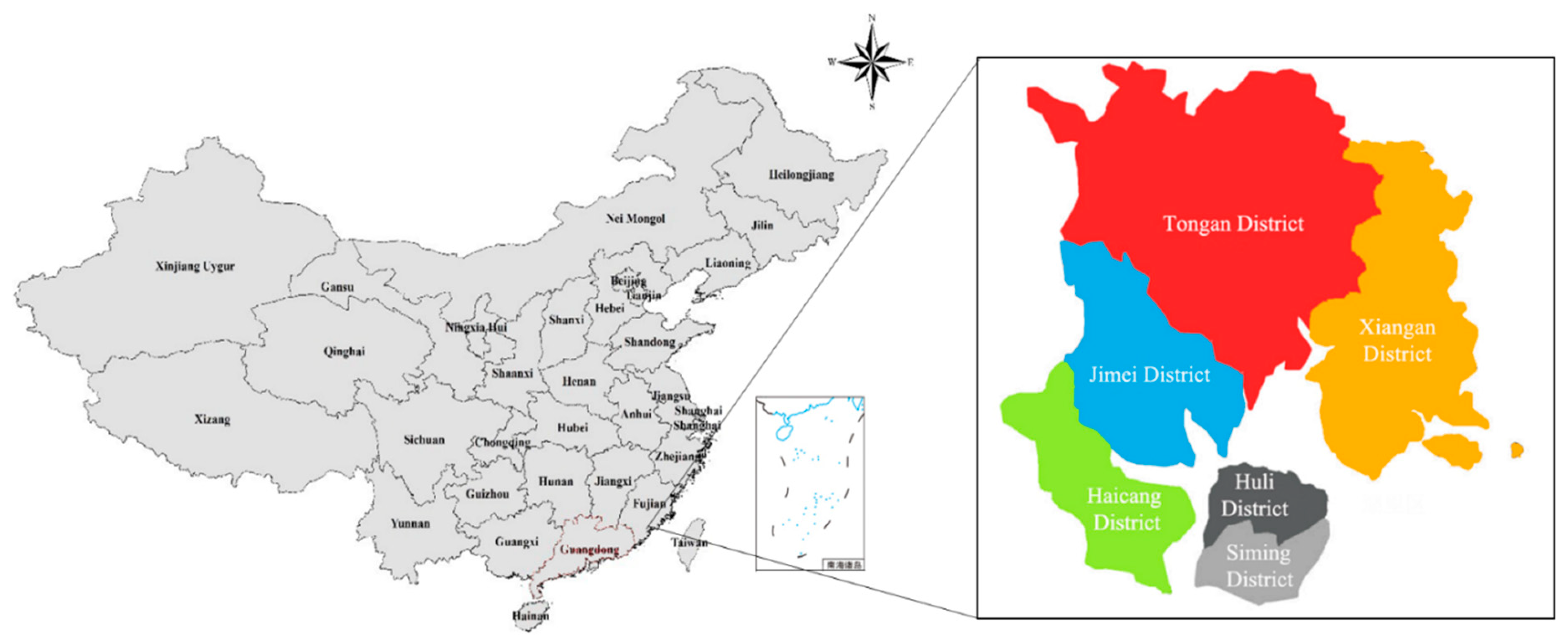

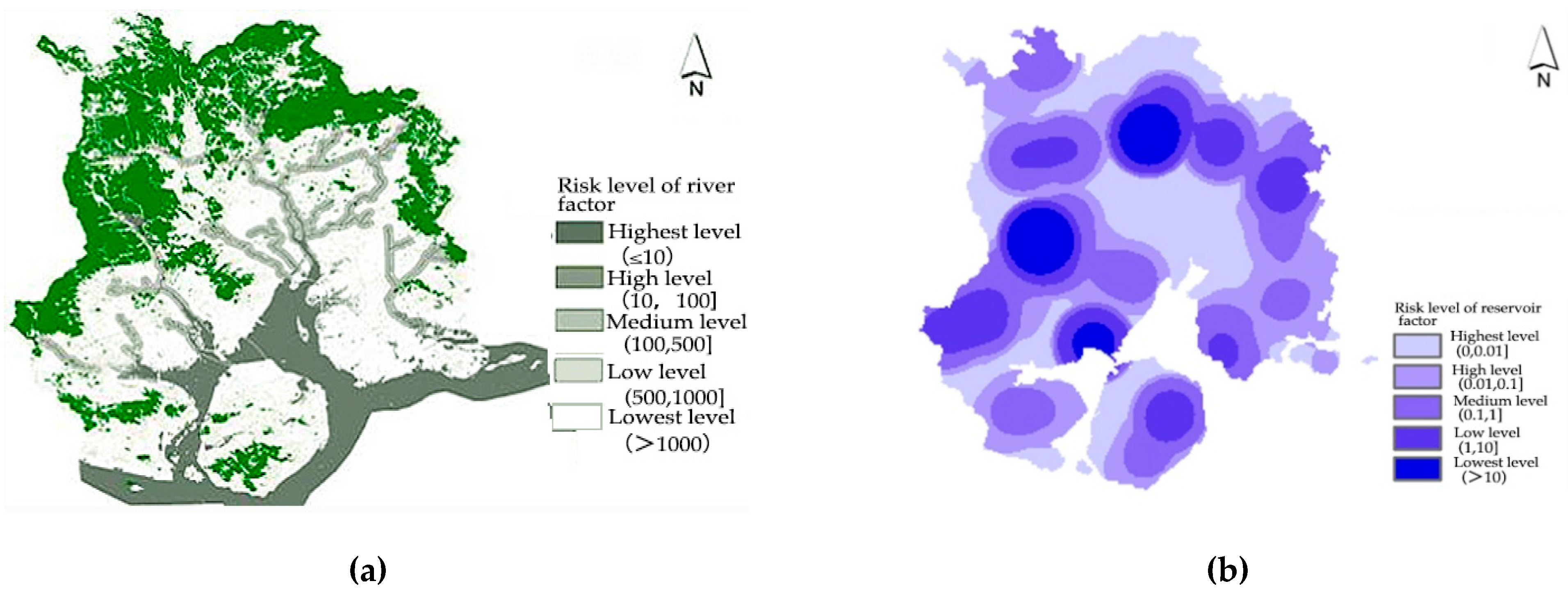



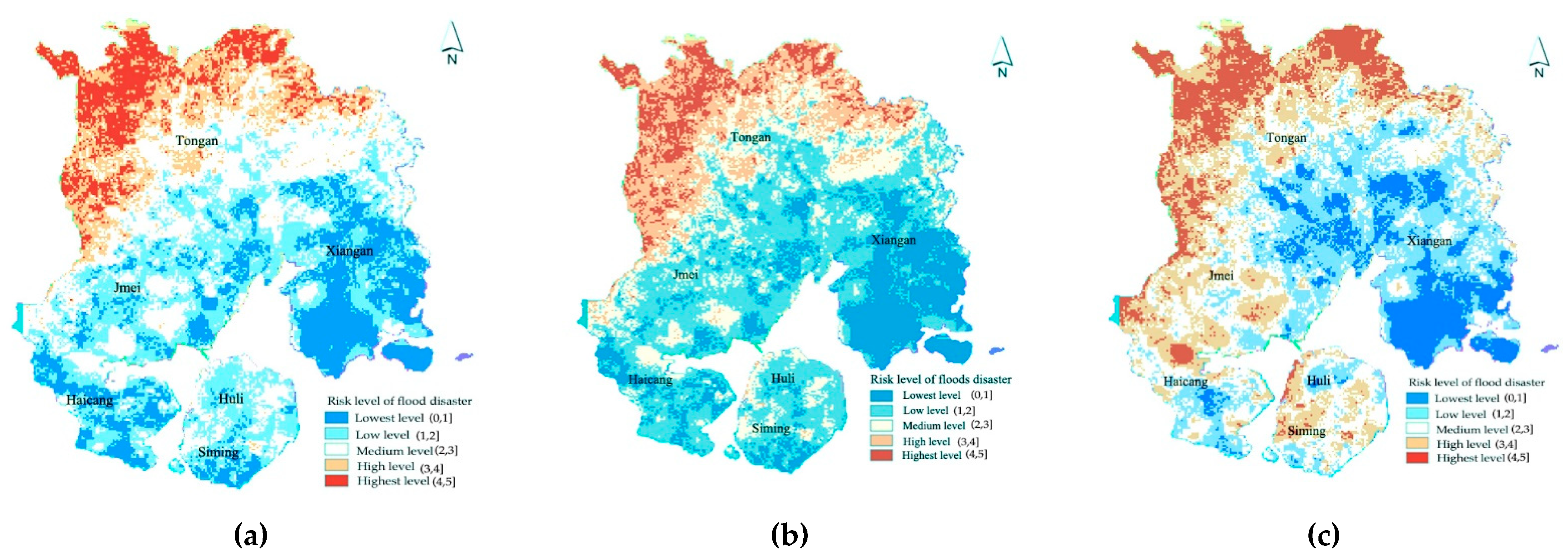
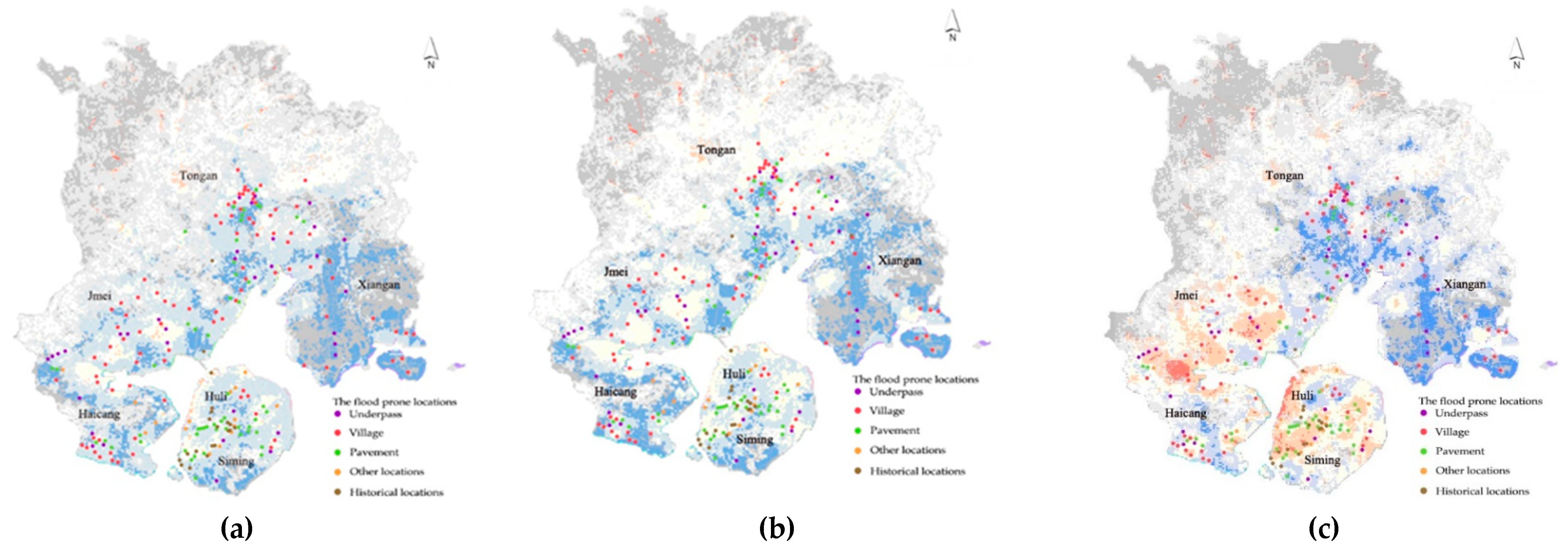
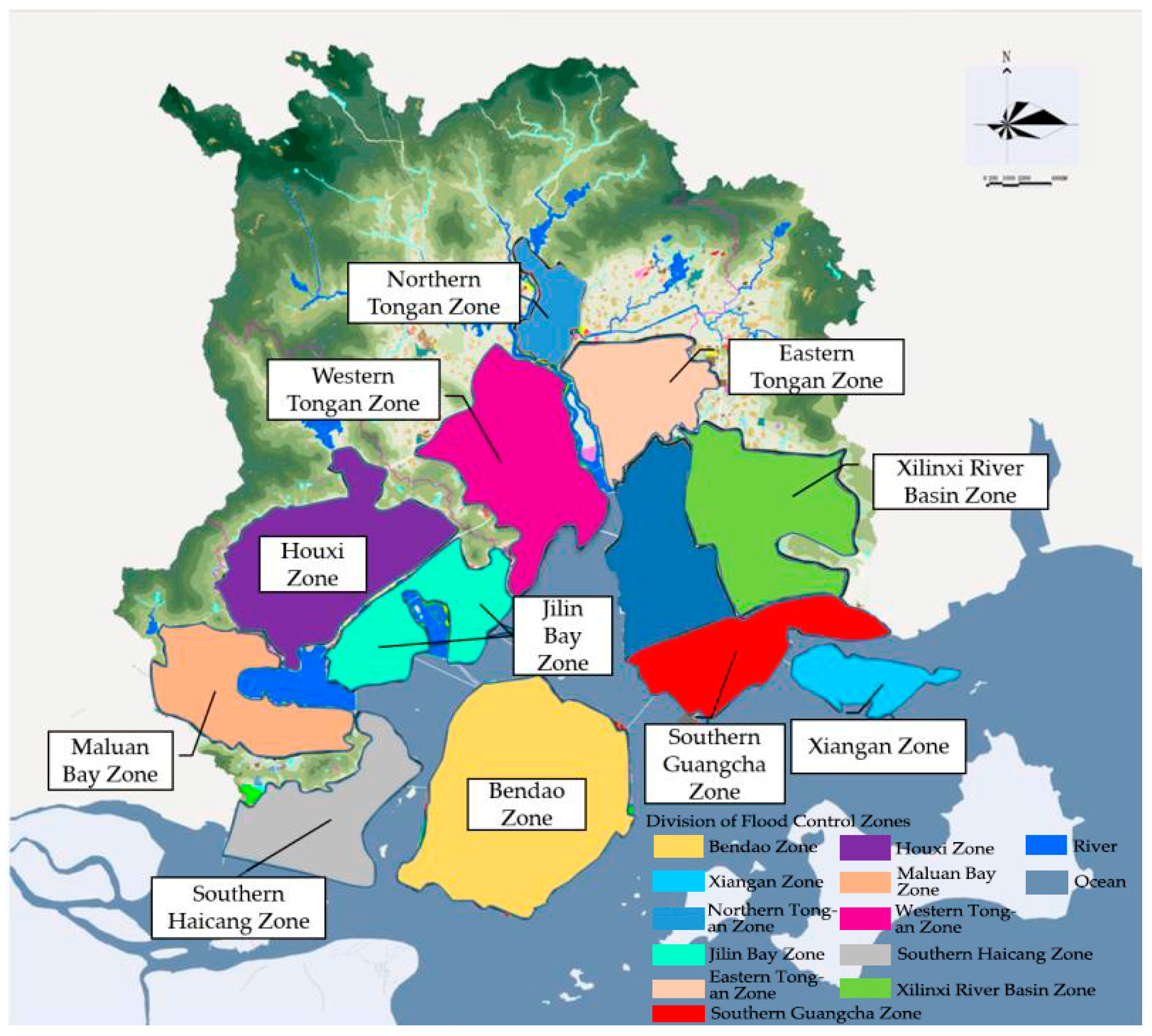
| Category | Sub-Category | Explanation 1,2 | Attribute | Weight |
|---|---|---|---|---|
| Hazard of disaster factors | Precipitation factor | Annual average precipitation, mean precipitation during flood season and precipitation during typhoon (unit: mm) | Positive | 0.1786 |
| Flood factor | Distance to the river (unit: m) and reservoir storage capacity (unit: m3) | Positive | 0.0815 | |
| Sensitivity to the environment | Terrain factor | Elevation (unit: m) and slope (unit: degree) | Positive | 0.1538 |
| Land factor | The proportion of cultivated land (unit: %) | Negative | 0.0393 | |
| River network factor | River network density (unit: %) | Positive | 0.0949 | |
| Vulnerability of the disaster-bearing body | Population vulnerability | Population density (unit: %) | Positive | 0.0387 |
| Economic vulnerability | Per capita GDP (unit: CNY) | Positive | 0.0274 | |
| Building vulnerability | Building quality (unit: null) and architectural age (unit: year) | Positive | 0.0531 | |
| Disaster prevention and resilience | Flood control capacity | Rainwater pipe network density (unit: %) | Negative | 0.1762 |
| Comprehensive response ability | Urbanization level (unit: %) and road network density (unit: %) | Negative | 0.1564 |
© 2019 by the authors. Licensee MDPI, Basel, Switzerland. This article is an open access article distributed under the terms and conditions of the Creative Commons Attribution (CC BY) license (http://creativecommons.org/licenses/by/4.0/).
Share and Cite
Shi, Y.; Zhai, G.; Zhou, S.; Lu, Y.; Chen, W.; Deng, J. How Can Cities Respond to Flood Disaster Risks under Multi-Scenario Simulation? A Case Study of Xiamen, China. Int. J. Environ. Res. Public Health 2019, 16, 618. https://doi.org/10.3390/ijerph16040618
Shi Y, Zhai G, Zhou S, Lu Y, Chen W, Deng J. How Can Cities Respond to Flood Disaster Risks under Multi-Scenario Simulation? A Case Study of Xiamen, China. International Journal of Environmental Research and Public Health. 2019; 16(4):618. https://doi.org/10.3390/ijerph16040618
Chicago/Turabian StyleShi, Yijun, Guofang Zhai, Shutian Zhou, Yuwen Lu, Wei Chen, and Jinyang Deng. 2019. "How Can Cities Respond to Flood Disaster Risks under Multi-Scenario Simulation? A Case Study of Xiamen, China" International Journal of Environmental Research and Public Health 16, no. 4: 618. https://doi.org/10.3390/ijerph16040618
APA StyleShi, Y., Zhai, G., Zhou, S., Lu, Y., Chen, W., & Deng, J. (2019). How Can Cities Respond to Flood Disaster Risks under Multi-Scenario Simulation? A Case Study of Xiamen, China. International Journal of Environmental Research and Public Health, 16(4), 618. https://doi.org/10.3390/ijerph16040618






